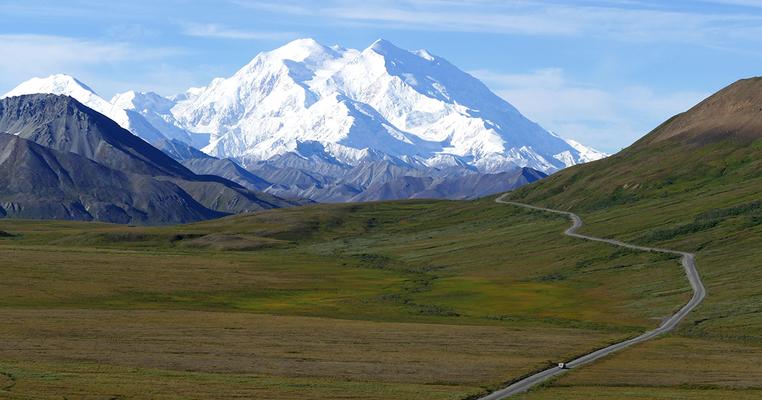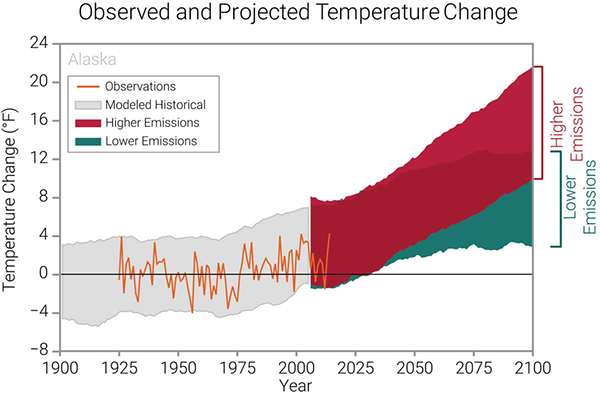
How Is the Climate Crisis Affecting Alaska?
Alaska is enormous. It’s the most enormous state in the union, actually, at more than half a million square miles. To visit the state is to fall in love with it – from the towering 20,000 feet of Mount Denali to the sprawling, harsh Arctic National Wildlife Refuge.
There’s something about the state that feels so immense and enduring, you might think that climate change couldn’t touch it. But record-breaking temperatures, rapidly melting ice, and huge, hungry wildfires tell a different story.
Alaska is on the front lines of this crisis.
>> Train with us – and take action for a better tomorrow <<
Rising Temperatures
Here’s the climate reality: In the last 50 years, Alaska has gotten about 2.5 degrees Fahrenheit warmer on average. And if we don’t stop burning fossil fuels, the state could see “historically unprecedented warming” by the end of this century.
Baked Alaska, indeed. The Last Frontier, as the state is sometimes called, is warming much faster than the lower 48 (the contiguous US has warmed by an average of 1.5 degrees Fahrenheit). Alaskans have experienced especially big departures from the average temperature during the winter and spring months.

Many towns in Alaska have been hit hard by rising temperatures, including Utqiaġvik, where the average temperature is up an astounding 7 degrees Fahrenheit.
For hundreds of years, Iñupiat people have made their lives in Utqiaġvik, located at the very northern tip of Alaska and considered the northernmost city in North America. But this drastic change in average temperature means that sea ice is melting, making traditional whalers travel further from the shore into more dangerous conditions in order to find the whales they depend on as a food source. And at the same time that families in Utqiaġvik are dealing with food supply concerns and changes to centuries-old traditions, their homes are in danger too — “across the North Slope, shorelines are eroding as warm ocean waters gnaw away at thawing permafrost bluffs.”
As biologist Craig George told the Anchorage Daily News, "The term is no longer 'climate change' at Utqiaġvik. It is 'climate changed.’”

As you can see from the map above, it’s safe to say it’s “climate changed” for the rest of the state, too. The International Arctic Research Center (IARC) at the University of Alaska Fairbanks noted in a 2019 report, “four of the past five years (2014–16, 2018) were warmer than any year prior to 2014.” This record-setting warmth has had two huge consequences for the state: melting sea ice and bigger, more frequent wildfires.
Changing Sea Ice
Here’s the climate reality: Sea ice plays a huge role in Alaska’s climate. And today, sea ice is forming later in the season and melting earlier. In fact, according to the National Park Service, “ice coverage in the Arctic is at the lowest levels ever recorded.”
In August of 2019, there was no ice off of Alaska’s coastline for 150 miles. None. That’s unprecedented. In fact, the average amount of ice covering ocean water around Alaska in September has gone down 13 percent over the last four decades — the equivalent of losing a hunk of sea ice the size of Scotland. And climate models show that, by 2050, Arctic waters could be totally ice-free in the late summer.
The IARC puts it starkly in its report:
“The presence of sea ice significantly modulates regional temperatures and moisture, determines the structure of the marine food web, and shapes the kinds of activities that people can or cannot do: from subsistence and travel to resource extraction to national security. Nothing in the Alaska environment is changing faster than sea ice.”
These dramatic changes in sea ice are impacting the lives of Alaskans across the state. In Newtok, a village about 400 Yupik people call home in southwestern Alaska, the story bears a lot of resemblance to Utqiagvik’s, even though almost 750 miles separate the two towns.
More than 20 years ago, it became clear that the permafrost Newtok was built on may not be so permanent after all, thanks to rising temperatures. As PBS NewsHour reported in 2019, “With the Earth warming, the permafrost their village sat on was melting, while rising seas were making the Ninglick River rise and erode the river line and coastline, on average, 70 feet a year.”
So the town voted to relocate nine miles away.
Starting in the fall of 2019, Yupik families began making the arduous move to the town’s new location. Community leaders are hoping the relocation will be completed by 2023. Gavin Dixon, the community development manager for the Alaska Native Tribal Health Consortium, told PBS NewsHour that in 2019, seven homes would have been swallowed up by the river had they already not been demolished.
Dixon said one of the biggest questions Newtok faced was, “How do you plan for something that happens slowly? A lot of times, when a community faces a disaster, it's an event. It's a tornado. It's a hurricane. It's an earthquake. And the effort to rebuild is based on that specific event. But what happens when it's a slow-moving disaster, like erosion or persistent flooding? And how do you plan for addressing a disaster like that?”
It’s a question many communities, in Alaska and around the globe, will have to answer in the coming decades, thanks to climate change.
Wildfires
Here’s the climate reality: Fueled by record temperatures and dried-out vegetation across the Last Frontier, wildfire season in Alaska is getting longer and longer.
Climate change creates the perfect conditions for extreme wildfire seasons. Warm weather is arriving sooner and sooner in Alaska, sometimes breaking heat records. Ice and snow are melting earlier in the season, too, leaving plant life to dry out and act as tinder for bigger, more destructive fires.

Data from IARC shows “wildfire seasons with more than one million acres (red bars in graph) burned have increased by 50 percent since 1990, compared to the 1950–1989 period.”
Wildfires in Alaska are expected to get more frequent and severe, and the amount of land burned is expected to double by the middle of this century – and then triple by the end of it.
Wildfires have serious implications for human health beyond just the immediate, extreme danger they present. NASA is funding a study to examine the impact Alaskan wildfires have had on residents’ health. Tatiana Loboda, a geography professor at the University of Maryland who is heading up the study, says the fine particulates released by fire are one of the greatest health concerns scientists see.
These particulates are truly microscopic – “the diameter of an average human hair is 30 times the size of a particulate that measures 2.5 microns” – but they can cause big problems, penetrating deep into our lungs and bloodstream. Exposure has been linked to burning eyes, heart and lung diseases, and even premature death – and these effects last long after the fire itself has been extinguished.
Here’s What You Can Do
Plain and simple, Alaska is being reshaped by climate change. But people like you can help reshape the narrative about this crisis in your community. Your friends and family trust you. When you speak, they listen. Learn how to use your position to open minds and inspire action by attending our next Climate Reality Leadership Corps training.
Climate Reality Leaders come from all walks of life. But they all share the same desire to make a difference and help create a sustainable future for our planet. Apply to become a Climate Reality Leader today!

